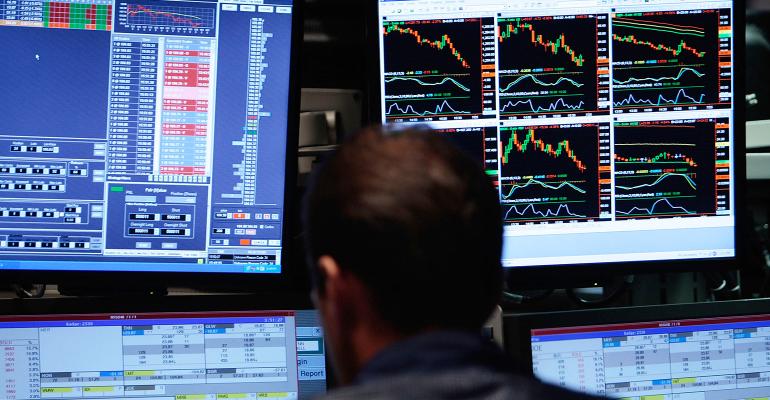(Bloomberg) -- Even as the raging Russia-Ukraine war caps risk appetite, U.S. stocks are still managing to beat long-term Treasuries by the biggest margin on record.
If two widely watched ETFs on Wall Street are anything to go by, the historic divergence may have room to run.
With the Federal Reserve’s inflation fight sparking record losses on fixed income just as dip buyers power the S&P 500, equities have recently outperformed long-duration debt by the fastest rate since the 2020 pandemic rebound.
After generally trading in lockstep earlier this year as both asset classes fell in tandem, the $411 billion SPDR S&P 500 exchange-traded fund, or SPY, has suddenly leaped above the nearly $19 billion iShares 20+ Year Treasury Bond ETF, known as TLT.
According to Bespoke Investment Group, SPY is besting TLT over the 10 trading days to Tuesday with the kind of momentum that was last seen in risk-on turning points in April 2020, October 2011, January 2009 and October 2002.
In the past four such episodes, a fresh stock rally took place the following year -- while bonds continued to suffer in the majority of cases.
The recent split in performance is notable given TLT has added more than $700 million of fresh money this week, while SPY saw an outflow $1.85 billion. In any case, the Bespoke analysis offers a warning to would-be dip buyers in the beaten-up world of long-dated Treasuries.
“Past times that the ratio of SPY to TLT has surged by a similar amount has resulted in further gains for equities and more weakness for TLT,” analysts at Bespoke wrote in a Tuesday note. “The average gain over the next year has also been stronger than the average gain for all periods since 2002.”
Equity investors are betting the global economic recovery will power ahead despite rising rates and enduring inflation, as sell-side strategists tout the ability of companies to weather price pressures and snarled supply chains. The S&P 500 has now recovered half its losses from a selloff that started in January.
By contrast, a mass exodus from bonds has gained momentum after the Fed signaled a steeper path toward tighter policy, with Chair Jerome Powell saying a half-point interest-rate hike is possible at the central bank’s next meeting. The most dramatic moves have taken root in short-dated securities but rates on longer-dated bonds have also climbed to pre-pandemic highs in a short timeframe.
Despite recent inflows into TLT, on a year-to-date horizon ETF investors have shown a clear preference for stocks, adding $126 billion since January, compared with an inflow of around $15 billion for bonds, data compiled by Bloomberg Intelligence show.
In other words, $8 has gone to equity funds for every dollar that fixed income attracted -- a preference in favor of risk not seen since 2016.
“Despite concerns that a hawkish Fed is bad for equities, history shows that stocks have rallied during previous tightening cycles,” said Art Hogan, chief market strategist at National Securities. “We’re seeing some early signs of that, with the S&P 500 Index rallying in five of the last six sessions. One possible reason is that equities are seen as a good hedge against rising prices because companies can pass those costs onto consumers.”
Read more: Bond-Markets Fright Feels Like 2007 All Over Again: John Authers
--With assistance from Lu Wang.





